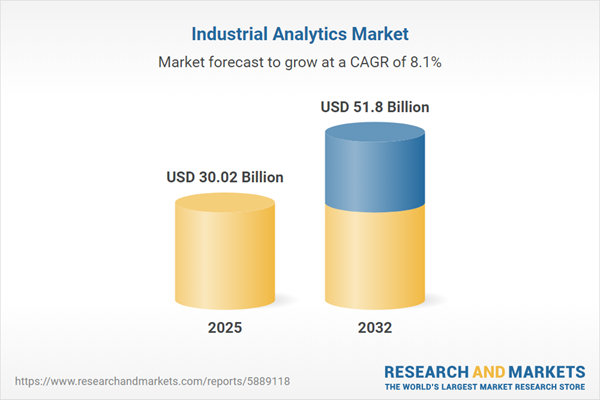Speak directly to the analyst to clarify any post sales queries you may have.
Industrial analytics is redefining how industrial leaders derive business value from complex operational data, supporting smarter decisions, sharper oversight, and resilient transformation strategies amid ongoing industry change.
Industrial Analytics Market Snapshot
The industrial analytics market is demonstrating strong growth, currently valued at USD 27.74 billion and projected to reach USD 30.02 billion within a year. Looking further ahead, the market is set to expand to USD 51.80 billion by 2032, with a compound annual growth rate (CAGR) of 8.11%. This robust momentum is fueled by organizations prioritizing the modernization of legacy systems, accelerating the adoption of scalable cloud-based platforms, and integrating analytics into broader digitization initiatives. As digital transformation deepens, the market’s advances highlight an industry-wide shift toward real-time operational insight, optimized supply chain management, and continuous performance improvement.
Scope & Segmentation of the Industrial Analytics Market
This comprehensive report addresses key market dynamics, delivering tailored intelligence for executives seeking to navigate technological disruption and global adoption in industrial analytics.
- Component: Consulting services, systems integration, technical support, business intelligence platforms, unified data management, and visual analytics form the backbone of operational upgrades and compliance initiatives.
- Analytics Type: Descriptive analytics provide insights into historical trends, predictive analytics anticipate future scenarios, and prescriptive analytics generate specific recommendations for routine and adverse events.
- Deployment Model: Organizations can choose from public, private, hybrid cloud, or on-premises deployments to align security, scalability, and business continuity with operational needs.
- Organization Size: Solutions are tailored for both large enterprises and small to mid-sized businesses, recognizing differences in digital maturity, resource allocation, and integration complexity.
- Application: Asset monitoring, predictive maintenance, quality assurance, compliance management, resource optimization, and supply chain efficiency all constitute key use cases that reinforce operational resilience.
- Industry Vertical: The report examines sector-specific requirements across chemical, manufacturing, energy, utilities, oil and gas, healthcare, and transportation, considering regulatory and business-driver differences.
- Region: Coverage spans global markets with dedicated analysis for the Americas, Europe, Middle East & Africa, and Asia-Pacific, focusing especially on countries like the United States, China, Germany, India, Saudi Arabia, and Nigeria.
- Industry Players: Profiles of leading providers—including Microsoft, IBM, General Electric, SAP, Siemens, PTC, Honeywell, Rockwell Automation, Oracle, and Hitachi Vantara—shed light on innovation strategies and the integration of advanced analytics solutions.
Key Takeaways for Senior Decision-Makers
- Organizations gain greater business agility through real-time analytics, allowing for dynamic adjustment of operational processes as market conditions change.
- Advanced machine learning capabilities are being leveraged to streamline workflows, drive efficiency, and allocate resources precisely across intricate industrial supply chains.
- Implementation of edge analytics boosts decentralized data processing, reducing vulnerabilities and facilitating rapid, localized decisions for time-sensitive activities.
- Strategically phased integration enables organizations to upgrade analytics without disrupting critical legacy infrastructure, supporting steady digital transformation and reducing transition risks.
- Operational visibility helps drive sustainability objectives, enabling compliance with dynamic regional and international regulations and improving energy management efforts.
- Tailored governance structures support regulatory alignment, streamline process compliance, and help reduce exposure to risks associated with evolving regional requirements.
Tariff Impact on Industrial Analytics Ecosystems
Recent tariff changes in the United States affecting imported hardware are driving companies utilizing on-premises industrial analytics to reassess their infrastructure costs and associated risk strategies. In response to these pressures, there is an acceleration in cloud migration initiatives, expansion of strategic partnerships, and diversification of supplier networks to adapt to shifting trade and supply chain realities.
Methodology & Data Sources
The findings in this report are grounded in a proven methodology that combines expert interviews, comprehensive quantitative industry surveys, and analysis of key trade publications. This approach ensures that insights are validated, reliable, and relevant for executive-level decisions.
Why This Report Matters
- Enables senior executives to benchmark their industrial analytics strategies and digital transformation progress against sector leaders and international standards.
- Equips leaders to clarify strategic and operational priorities, with a clear line-of-sight into regulatory, technological, and market requirements worldwide.
- Delivers actionable guidance for evaluating analytics technologies and vendors, accounting for critical differences among industries, geographies, and compliance environments.
Conclusion
Industrial analytics empowers business leaders to drive continuous improvement across all stages of digital transformation. This report equips decision-makers with the insight needed for effective strategy within data-driven industrial environments.
Additional Product Information:
- Purchase of this report includes 1 year online access with quarterly updates.
- This report can be updated on request. Please contact our Customer Experience team using the Ask a Question widget on our website.
Table of Contents
3. Executive Summary
4. Market Overview
7. Cumulative Impact of Artificial Intelligence 2025
Companies Mentioned
The companies profiled in this Industrial Analytics market report include:- Microsoft Corporation
- International Business Machines Corporation
- General Electric Company
- SAP SE
- Siemens AG
- PTC Inc.
- Honeywell International Inc.
- Rockwell Automation, Inc.
- Oracle Corporation
- Hitachi Vantara LLC
Table Information
| Report Attribute | Details |
|---|---|
| No. of Pages | 185 |
| Published | October 2025 |
| Forecast Period | 2025 - 2032 |
| Estimated Market Value ( USD | $ 30.02 Billion |
| Forecasted Market Value ( USD | $ 51.8 Billion |
| Compound Annual Growth Rate | 8.1% |
| Regions Covered | Global |
| No. of Companies Mentioned | 11 |









